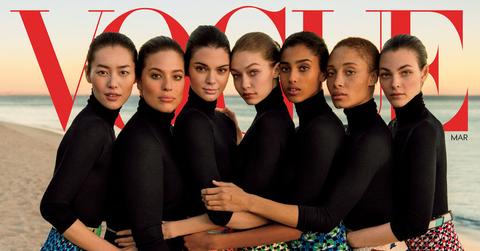Why It Was Important Karlie Kloss Apologized For Vogue Geisha Photoshoot

Vogue released its March issue celebrating (yep – you guessed it) – cultural diversity. And it was (yep – you guessed it) – a total disaster. Which is all so sad because just last week we were really rooting for the fashion industry to get it right this time.
Hey, Vogue: Embracing diversity does not mean styling Karlie Kloss as a geisha https://t.co/GnW04ejz4vpic.twitter.com/LZSQzIF3eb
— The Cut (@TheCut) February 14, 2017
Karlie Kloss gets a 6-page spread in yellowface for Vogue’s DIVERSITY ISSUE… while Imaan Hammam & Liu Wen get one pic each… the irony pic.twitter.com/fXn9Ikz7ik — Nerdy Asians (@NerdyAsians) February 15, 2017
Last week, the industry came out strong, unitedly taking a stance against the oppressive hatred spouting from the Trump regime in the year’s biggest event, Fashion Week. White bandanas – a symbol repped as part of a larger campaign uniting the industry together in humanity and against hatred – took over the runways, the red carpets, and the rest of New York City.
Pink pins supporting Planned Parenthood were on the lapels of fashion industry giants, including Anna Wintour. Wintour herself stated that she believed the industry had woken up to celebrating diversity.
In an interview with The Wall Street Journal, Wintour stated, ““It seemed to us that it was time to celebrate and be positive and optimistic and say, ‘look at all these incredibly talented people we have working not only in fashion but in every possible walk of life.’”
Yet barely a week later, Wintour’s own magazine published a full spread of the blonde hair, blue eyed, All-American Karlie Kloss dressed full-on as a Japanese geisha. Because DIVERSITY.
People are furious Karlie Kloss dressed like a geisha for Vogue’s diversity issue https://t.co/vhDN38zPZFpic.twitter.com/tz1ZxQ7edp — BuzzFeed (@BuzzFeed) February 15, 2017
To be fair, all the signs Vogue’s March issue would be a creative disaster were there. Before the magazine’s limited release on Valentines Day, there was already pushback against the cover. Though the issue showcased multiple women, all but one plus size model had the same, waif body type. And although there are models from different racial and cultural backgrounds on the cover, they all somehow, miraculously, have strikingly similar bone structures, and skin tones that are ‘extremely light.’
We could go on about the lapses of insight plaguing the controversial cover (i.e. how diverse body types applies to body shape – not just size. Or how internalized racism deems lighter skin tones to be more ‘beautiful’). But instead, lets just focus on the most obvious, mind-numbing decision to place Karlie Kloss in a kimono and call it “diversity.”
What were they thinking?
Emma Stone, Scarlett Johansson, and Tilda Swinton turn to Karlie Kloss. “Your turn, girl.”
Karlie on phone: “Hello, Vogue? Make me Asian.” pic.twitter.com/zgUWIB022Q
— Ira Madison III (@ira) February 14, 2017
Kloss for her part apologized in a statement, saying, “These images appropriate a culture that is not my own and I am truly sorry for participating in a shoot that was not culturally sensitive. My goal is, and always will be, to empower and inspire women. I will ensure my future shoots and projects reflect that mission.”
— Karlie Kloss (@karliekloss) February 15, 2017
That’s nice. Except this isn’t Kloss’ first altercation. Five years ago Kloss waltzed down the Victoria Secrete’s runway clad in an Indian headdress, with matching bra, panty and high-healed moccasins. Because THANKSGIVING.
Kloss apologized then too. But considering the onset of white American women taking on roles from different races and cultures (particularly Asian cultures) – including Scarlett Johansson‘s Japanese appropriation in Ghost in a Shell, Emma Stone‘s half Asian character in Aloha, and Tilda Swinton‘s Dr. Strange Tibetan character defense that ran straight into a proverbial white feminist wall – it seems pretty clear that many white women within Hollywood have no problem appropriating their Asian counterparts if money and notoriety are involved. This is especially true considering all of the women mentioned above have either identified as feminists, or have directly spoken to feminist issues.
To use Johansson’s own words, this kind of outlook on feminism only pushes women’s equality ‘backwards.’
Until we recognize that feminism should speak to the diverse issues and experiences of marginalized women, ‘progress’ will only be defined by the access of white women to opportunity. And that progress will continue to be built on the backs of colored women.
To Kloss’ credit, she did apologize where others, like Swinton, did not. However, the blame shouldn’t just be on the actresses or models taking on these roles. Creative directors, hiring managers, and editors all get a say in casting decisions. There’s no excuse to continue to culturally appropriate roles. There’s no excuse to continuously promote white only body types and features. There’s no excuse to cast Karlie Kloss as a geisha.





